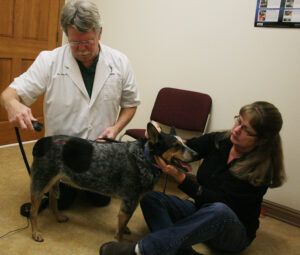
By Jean Schurman
We all hurt when our animal hurts, especially if it is an old dog or a beloved cat. Just like humans, these animals suffer from the aches and pains of bones and joints that have become stiff with time. Now there is a new therapy in Stevensville that is giving relief to these animals. However the practice is not limited to geriatric pets. Animals that have been injured or had surgery are also benefiting from this relatively new technique.
Dr. Steve Watters is now practicing at the Burnt Fork Veterinary Clinic on Wednesdays. Along with the normal day-to-day practices such as worming, spaying or neutering, Dr. Watters is now treating his four legged patients with low level laser therapy. This treatment is a non-invasive treatment. Immediately upon hearing the word laser, an image is conjured up of a surgeon in a white coat wearing protective goggles, as is everyone else in the room, including the patient. After all, lasers can be strong enough to cut, burn or destroy tissue.
Imagine my surprise when I entered the examination room where Nicholas, a 13-year-old Australian Cattle Dog, was about to get a treatment. His owners, Dave and Candy Clark, were in the room with the dog and Watters. No one was wearing protective eye gear. In fact, Candy was on the floor holding the dog’s leash and Watters was kneeling right beside the dog. He held an apparatus that looked something like a light meter or a hand-held battery charger. I didn’t notice until a bit later that Candy was also holding a small black object that was wired to the device Watters had.
Once the treatment started, it was almost a ‘non event’. Watters slowly moved the device back and forth over Nicholas’ hindquarters. As he pulled his hand away from the dog, you could see two red lines of light. He explained the laser, often called a ‘cold laser,’ is set at a specific frequency that doesn’t ‘burn’. Nicholas stood quietly and moved when asked but was in no discomfort.
One thought on why this works is that the low level laser therapy or LLLT treatments reduces the swelling of the cell tissues and increases blood flow to the affected areas especially in animals affected by arthritis and other structural conditions. This treatment first received FDA approval in 2002 under a new classification of therapeutic devices called NHN2 or non-heating modalities, commonly known as biostimulation. Dr. Watters believes this type of treatment stimulates the cells to heal themselves.
Dr. Watters uses the LLLT on dogs with neurological problems such as arthritis, back pain and dogs with hip problems. He also has used it on wound treatments after surgery. He believes it helps speed up the recovery from the surgery. He said he had used this treatment on a dog that had a severe spider bite.
“The area was infected and tissue was dying but with the treatment, it stopped the spreading (of the infection.)”
This treatment has also been used on horses and is very effective but because horses are very sensitive to the treatment, the option hasn’t been used much at the vet clinic.
Dr. Watters is a graduate of Iowa State Univeristy. He has been practicing in Montana for three years. Along with working at Burnt Fork Veterinary Clinic, he does some relief work for other veterinarians. For more information, call 777-3844.